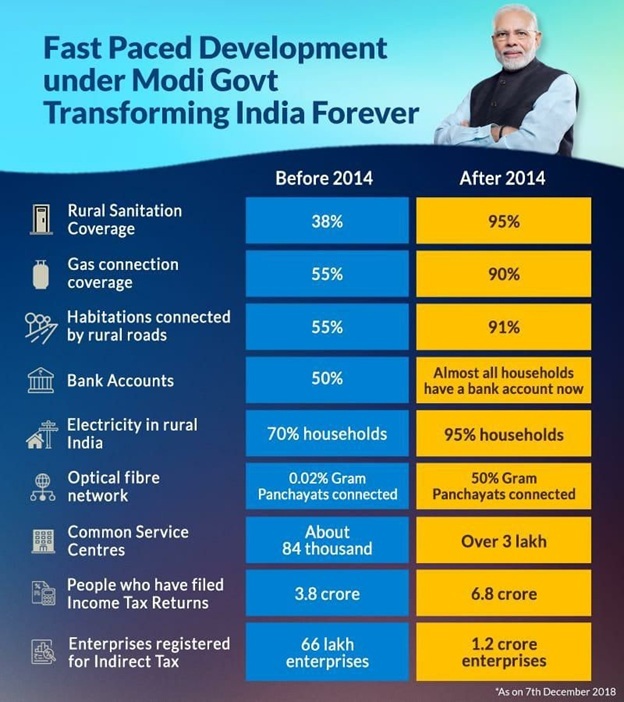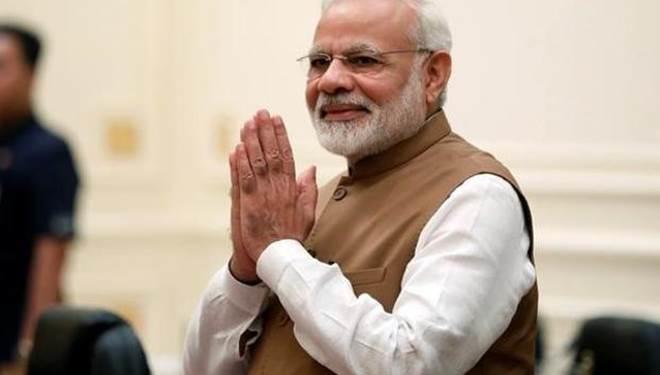The country has taken a great leap forward on the development front in the last four and a half years of Modi government. The social security has expanded to cover the majority of the citizens of the country and tax net has widened. The country is moving from a patronage-based economy to ‘rule-based capitalist economy’. In the last seven decades, governments promised to make the country a welfare state but when Modi government came to power in May 2014, more than 50 percent of the households did not even have a bank account. Under the leadership of PM Modi, the country is making exceptional progress on every socio-economic indicator and moving towards becoming a welfare state.
The rural sanitation coverage in India was worst among BRICS countries when the Modi government came to power. Less than 40 percent of the rural households had basis sanitation facilities like toilets. The open defection in rural areas was the reason behind much infectious disease typhoid, cholera, hepatitis, polio, trachoma. Modi government vowed to make the country Open Defecation Free (ODF). In less than 5 years almost all households in the country have toilets.

When Modi government came to power only 55 percent of the households had LPG connections. Majority of the households in rural areas used woods, coal, kerosene oil or some other polluting fossil fuel for cooking. Use of these fossil fuels is harmful for personal and environmental health and this was the reason behind many respiratory diseases like Asthma. Modi government gave subsidized gas cylinders and stoves to households which do not have LPG connection. As of December 2018, almost 90 percent of the households have LPG connections.
The programme of connecting rural households with roads which were started by Vajpayee government culminated under PM Modi. Today more than 90 percent of the rural habitations are connected by rural roads. Electricity connection to every household was promised by Congress decades back but only 70 percent of the households had electricity connection in 2014. As of now, almost 95 percent of the households have electricity connection. Under the Saubhagya Scheme or Pradhan Mantri Sahaj Bijli Har Ghar Yojana, Modi government provides electricity connection, LED bulbs and fan to poor households.
The one thing which expanded at the most rapid pace is digitalization. Under the ‘Digital India’ initiative, many programmes were launched by the Modi government to provide Internet connection to every village and possibly every household. The optical fiber network in villages was almost negligible. As of December 2018, half of the gram panchayats are connected by an optical fiber network. The number of Common Service Centers (CSC) which provides e-services to the rural and remote location was less than one lakh when Modi government came to power and the number increased more than 3 lakhs as of this year. The prices for internet connection crashed since the entry of Jio. Today India has one of the cheapest internet tariffs in the world.
These welfare schemes provided by Modi government were supported by an increase in the tax net. The number of direct taxpayers in the country increased by more than two third in the last four and a half years. In FY 14, 3.8 crore people filed IT returns and the number has increased to 6.8 crores in previous fiscal year and expected to increase further after the implementation of GST because the indirect tax reform is helping in widening the direct tax bracket too. The number of enterprises registered for the indirect tax has also increased from 66 lakh to 1.2 crores under the Modi government and expected to increase exponentially in this financial year given the successful implementation of GST.
The previous governments promised a lot but delivered little while PM Modi started with very small initiatives to deliver basic facilities to people and delivered on those.


































